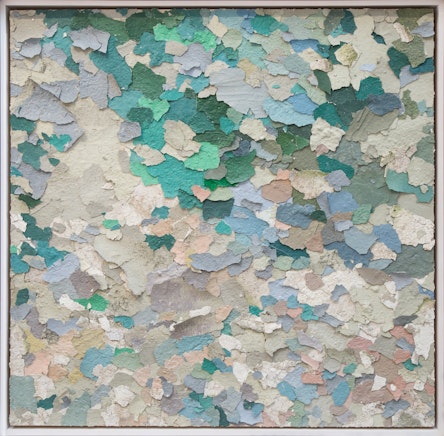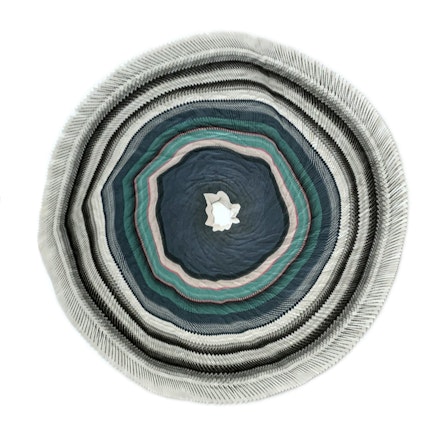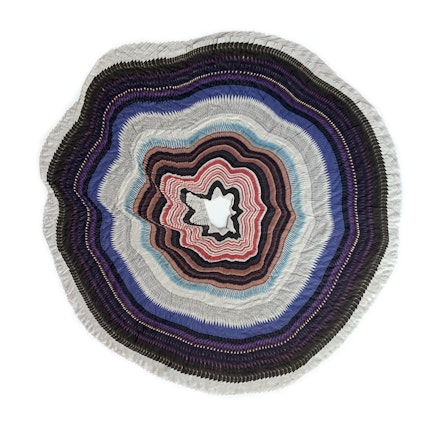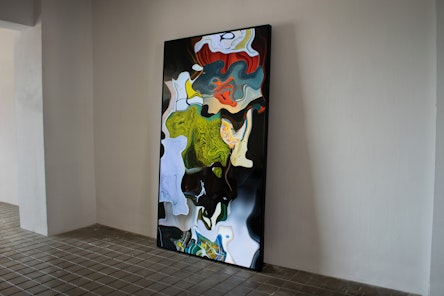
Max Estrella Gallery returns for a tenth time to Art Bo, with a display including the works of Miler Lagos, Rafael Lozano-Hemmer, Daniel Canogar, Diana Fonseca, y Nacho Martín Silva. Diana Fonseca presents her series Degradaciones, reflecting on the passing of time and the subject of memory. These are abstract collages made with fragments of buildings in La Habana. The series Anillos del Tiempo, which translates as Rings of Time, by Miler Lagos, is equally a reference to memory, and specifically to nature’s memory. Made with newspapers, each ring reverses the process of manufacturing paper, returning it back to the tree. Rafael Lozano-Hemmer shows Recurrent Rayuela, an interactive piece containing the 155 episodes in the masterpiece by Julio Cortázar. It works with a rotating screen showing fragments of the book when activated by the viewer, which disappear when motion stops. Daniel Canogar, the other important digital artist represented by the gallery, shows Amalgama Phillips, a generative animation that liquefies artwork from the Phillips collection, appropriating them to create an abstraction. Finally, the gallery presents Nacho Martín Silva fragmented paintings, in which the Madrid-based author reviews the issue of truthfulness in images and what is represented in them. He establishes a close dialogue with the pictorial medium, considering each fragment of the painting independently. They provide him the space to be different types of painter.
Max Estrella opened in 1994. The foundational mission was to present both a new generation of emerging, and a group of consolidated artists. Local and international. An exceptional roster represents our purpose of breaking new ground in contemporary art, whether it is video, painting, photography, sculpture and installation, with a special focus on new technologies.

Diana Fonseca is a creator interested in dismantling, almost obsessively, the simple things of life, and everyday events. Perhaps for that reason, or because of the lyrical propensity of her work, she catches varied images of reality and interconnects them in narratives that talk about disparity and inconsistencies; about contemporary life and visual saturation; about emptiness and banality. Graduated from the Higher Institute of Art (ISA) in 2005, Fonseca is one of the most interesting contemporary Cuban artists. Among her most interesting solo projects we can find “Cara a cara”, two-person project with Jacques Villeglé in the Brownstone Foundation, Paris, France; “Diana Fonseca”, presented at the Sean Kelly Gallery in New York, USA; “Viaje a la semilla”, two-person show developed with Aimée García at Factoria Habana, in Havana, Cuba. In 2015 she was awarded with the EFG Bank & ArtNexus Acquisition Prize, Bogota, Colombia. She has also received the Cast Research Residency, Melbourne, Australia (2016) and the JustMad Residency, Asturias, Spain (2017). Fonseca’s Degradations are pieces structured with layers of paint taken from different façades in Havana. This random overlap of solidified layers of old paint generates an abstract artwork that captures the history of the city, personal and collective stories, more or less anonymous, rearticulated now in an autonomous piece.

Diana Fonseca is a creator interested in dismantling, almost obsessively, the simple things of life, and everyday events. Perhaps for that reason, or because of the lyrical propensity of her work, she catches varied images of reality and interconnects them in narratives that talk about disparity and inconsistencies; about contemporary life and visual saturation; about emptiness and banality. Graduated from the Higher Institute of Art (ISA) in 2005, Fonseca is one of the most interesting contemporary Cuban artists. Among her most interesting solo projects we can find “Cara a cara”, two-person project with Jacques Villeglé in the Brownstone Foundation, Paris, France; “Diana Fonseca”, presented at the Sean Kelly Gallery in New York, USA; “Viaje a la semilla”, two-person show developed with Aimée García at Factoria Habana, in Havana, Cuba. In 2015 she was awarded with the EFG Bank & ArtNexus Acquisition Prize, Bogota, Colombia. She has also received the Cast Research Residency, Melbourne, Australia (2016) and the JustMad Residency, Asturias, Spain (2017). Fonseca’s Degradations are pieces structured with layers of paint taken from different façades in Havana. This random overlap of solidified layers of old paint generates an abstract artwork that captures the history of the city, personal and collective stories, more or less anonymous, rearticulated now in an autonomous piece.

Diana Fonseca is a creator interested in dismantling, almost obsessively, the simple things of life, and everyday events. Perhaps for that reason, or because of the lyrical propensity of her work, she catches varied images of reality and interconnects them in narratives that talk about disparity and inconsistencies; about contemporary life and visual saturation; about emptiness and banality. Graduated from the Higher Institute of Art (ISA) in 2005, Fonseca is one of the most interesting contemporary Cuban artists. Among her most interesting solo projects we can find “Cara a cara”, two-person project with Jacques Villeglé in the Brownstone Foundation, Paris, France; “Diana Fonseca”, presented at the Sean Kelly Gallery in New York, USA; “Viaje a la semilla”, two-person show developed with Aimée García at Factoria Habana, in Havana, Cuba. In 2015 she was awarded with the EFG Bank & ArtNexus Acquisition Prize, Bogota, Colombia. She has also received the Cast Research Residency, Melbourne, Australia (2016) and the JustMad Residency, Asturias, Spain (2017). Fonseca’s Degradations are pieces structured with layers of paint taken from different façades in Havana. This random overlap of solidified layers of old paint generates an abstract artwork that captures the history of the city, personal and collective stories, more or less anonymous, rearticulated now in an autonomous piece.

Miler Lagos’ practice has as its starting points dialogue and experimentation with materials, catalysts for the central issues of his discourse. He reflects on the relationship between images and objects, content and container. Wood and paper have served as media for representing his interest in the intersection of nature and culture. There is a profound concern with studying the way human beings have modeled their space or has been modeled by environmental and geographic conditions. In addition, there is an intention of raising awareness about conservation of the environment and the way we are gradually turning nature into a resource to inhabit, into raw material, merely a vehicle. Miler Lagos’ work is present at the collections of MUAC Museo de Arte de la Universidad Autónoma de México, Harvard University, Bank of the Republic of Colombia, the Rubell Family Collection and CIFO Cisneros Fontalas Art Foundation, among others. Anillos del tiempo (Rings of time) is a series of collages created from 400 copies of the same page of a Newspaper. The origin of this piece lies in the rings that can be seen inside the trunk of a tree once it is cut. These not only reveal the age of the tree, but also provide information about the environmental conditions that affected the trunk through time. The arrangement of the pages evokes the concentric circles that time engraves in trees, turning them into archives of information and witnesses of memory.

Miler Lagos’ practice has as its starting points dialogue and experimentation with materials, catalysts for the central issues of his discourse. He reflects on the relationship between images and objects, content and container. Wood and paper have served as media for representing his interest in the intersection of nature and culture. There is a profound concern with studying the way human beings have modeled their space or has been modeled by environmental and geographic conditions. In addition, there is an intention of raising awareness about conservation of the environment and the way we are gradually turning nature into a resource to inhabit, into raw material, merely a vehicle. Miler Lagos’ work is present at the collections of MUAC Museo de Arte de la Universidad Autónoma de México, Harvard University, Bank of the Republic of Colombia, the Rubell Family Collection and CIFO Cisneros Fontalas Art Foundation, among others. Anillos del tiempo (Rings of time) is a series of collages created from 400 copies of the same page of a Newspaper. The origin of this piece lies in the rings that can be seen inside the trunk of a tree once it is cut. These not only reveal the age of the tree, but also provide information about the environmental conditions that affected the trunk through time. The arrangement of the pages evokes the concentric circles that time engraves in trees, turning them into archives of information and witnesses of memory.

Miler Lagos’ practice has as its starting points dialogue and experimentation with materials, catalysts for the central issues of his discourse. He reflects on the relationship between images and objects, content and container. Wood and paper have served as media for representing his interest in the intersection of nature and culture. There is a profound concern with studying the way human beings have modeled their space or has been modeled by environmental and geographic conditions. In addition, there is an intention of raising awareness about conservation of the environment and the way we are gradually turning nature into a resource to inhabit, into raw material, merely a vehicle. Miler Lagos’ work is present at the collections of MUAC Museo de Arte de la Universidad Autónoma de México, Harvard University, Bank of the Republic of Colombia, the Rubell Family Collection and CIFO Cisneros Fontalas Art Foundation, among others. Anillos del tiempo (Rings of time) is a series of collages created from 400 copies of the same page of a Newspaper. The origin of this piece lies in the rings that can be seen inside the trunk of a tree once it is cut. These not only reveal the age of the tree, but also provide information about the environmental conditions that affected the trunk through time. The arrangement of the pages evokes the concentric circles that time engraves in trees, turning them into archives of information and witnesses of memory.

Nacho Martín Silva’s practice seeks to take apart the image and find the ideological content that is revealed through excess. Taking Art History and the creative process itself as key elements to his practice, he reflects on how to face the underlying subject matter to images. Decomposing it is a constant feature in his work. Enigmatic episodes, far from simply representing historical events, offer a whole set of optics to approach that single moment in time, which questions its veracity. Martín Silva presents a multifocal narrative. He appropriates images from paintings, books, magazines, newspapers, photos, movies, videos and digital files. His goal is to find proofs of the creation of global realities out of local fictions. Nacho Martín Silva lives and works in Madrid. He has presented solo exhibitions in Centro de Arte Alcobendas (Madrid), Spring Break Art Show (New York) and Fundació Pilar i Joan Miró (Mallorca). He received the Pilar Juncosa & Sotheby’s Biennial Award for Artistic Creation as well as a Casa Velázquez Residency. His work is present in multiple collections such as Jorge Pérez, María Cristina Masaveu Peterson, DKV, and Absolut, among others. In ´pôs(t)kärd, Martín Silva appropriates postcards with scenes of the American way of life’s ideal family model. Brought to Spain and many other countries after the Second World War, this ideal family responded to the needs of the market to create new consumers. Adverts and publications in the 1960s were conceived to create an artificial reality based on the power of images. The title of the series, written according to the phonetic transcription of the English word postcard, alludes to the complex system of traditions that are necessary to build meaning. In this case, that of an alien family model, the circumstances and particularities of the place in which it is tried to establish.

Nacho Martín Silva’s practice seeks to take apart the image and find the ideological content that is revealed through excess. Taking Art History and the creative process itself as key elements to his practice, he reflects on how to face the underlying subject matter to images. Decomposing it is a constant feature in his work. Enigmatic episodes, far from simply representing historical events, offer a whole set of optics to approach that single moment in time, which questions its veracity. Martín Silva presents a multifocal narrative. He appropriates images from paintings, books, magazines, newspapers, photos, movies, videos and digital files. His goal is to find proofs of the creation of global realities out of local fictions. Nacho Martín Silva lives and works in Madrid. He has presented solo exhibitions in Centro de Arte Alcobendas (Madrid), Spring Break Art Show (New York) and Fundació Pilar i Joan Miró (Mallorca). He received the Pilar Juncosa & Sotheby’s Biennial Award for Artistic Creation as well as a Casa Velázquez Residency. His work is present in multiple collections such as Jorge Pérez, María Cristina Masaveu Peterson, DKV, and Absolut, among others. In ´pôs(t)kärd, Martín Silva appropriates postcards with scenes of the American way of life’s ideal family model. Brought to Spain and many other countries after the Second World War, this ideal family responded to the needs of the market to create new consumers. Adverts and publications in the 1960s were conceived to create an artificial reality based on the power of images. The title of the series, written according to the phonetic transcription of the English word postcard, alludes to the complex system of traditions that are necessary to build meaning. In this case, that of an alien family model, the circumstances and particularities of the place in which it is tried to establish.

Nacho Martín Silva’s practice seeks to take apart the image and find the ideological content that is revealed through excess. Taking Art History and the creative process itself as key elements to his practice, he reflects on how to face the underlying subject matter to images. Decomposing it is a constant feature in his work. Enigmatic episodes, far from simply representing historical events, offer a whole set of optics to approach that single moment in time, which questions its veracity. Martín Silva presents a multifocal narrative. He appropriates images from paintings, books, magazines, newspapers, photos, movies, videos and digital files. His goal is to find proofs of the creation of global realities out of local fictions. Nacho Martín Silva lives and works in Madrid. He has presented solo exhibitions in Centro de Arte Alcobendas (Madrid), Spring Break Art Show (New York) and Fundació Pilar i Joan Miró (Mallorca). He received the Pilar Juncosa & Sotheby’s Biennial Award for Artistic Creation as well as a Casa Velázquez Residency. His work is present in multiple collections such as Jorge Pérez, María Cristina Masaveu Peterson, DKV, and Absolut, among others. In ´pôs(t)kärd, Martín Silva appropriates postcards with scenes of the American way of life’s ideal family model. Brought to Spain and many other countries after the Second World War, this ideal family responded to the needs of the market to create new consumers. Adverts and publications in the 1960s were conceived to create an artificial reality based on the power of images. The title of the series, written according to the phonetic transcription of the English word postcard, alludes to the complex system of traditions that are necessary to build meaning. In this case, that of an alien family model, the circumstances and particularities of the place in which it is tried to establish.

Daniel Canogar is the most significant Spanish artist working with interactive art. He is interested in portraying the impact of technology in our way of life. For instance, Canogar reflects on the substantial change in our relationship with screens. These are acquiring a new materiality, a membrane quality that extends over multiple surfaces, objects and buildings. Big data is also a major line of study. Especially information connected to environmental phenomenaand that’s available in real time. Daniel Canogar lives and works in Madrid and Los Angeles. He has a number of public spaces installations, such as Waves at Houston Center’s atrium; Travesías at the European Council in Brussels; Tendril at Tampa International Airport; and Constellations, the largest photographic mosaic in Europe at Madrid Río Park. Most recently he showed Storming Times Square, a video intervention at Times Square’s screens. His works have been exhibited at Museo Reina Sofía, Madrid, National History Museum, New York, and Andy Warhol Museum, Pittsburg, among others. Recently presented at the Phillips Collection on the ocassion of its 100th Anniversary, Amalgama Phillips is a generative animation. The Museum’s entire collection is transformed by an algorithm that liquefies the original paintings into a mercurial blend. Amalgama Phillips is an attempt to understand how digital media is transforming our experience of the history of art, perhaps updating Malraux’s Musée Imaginaire to the digital age. The swirling effects that have transformed the original artworks evoke the ceaseless flow of information that courses through the Internet, transforming how artworks are consumed, processed and circulated online. This work, above all, addresses the challenge of making, viewing and circulating art in our liquid modernity.

Daniel Canogar is the most significant Spanish artist working with interactive art. He is interested in portraying the impact of technology in our way of life. For instance, Canogar reflects on the substantial change in our relationship with screens. These are acquiring a new materiality, a membrane quality that extends over multiple surfaces, objects and buildings. Big data is also a major line of study. Especially information connected to environmental phenomenaand that’s available in real time. Daniel Canogar lives and works in Madrid and Los Angeles. He has a number of public spaces installations, such as Waves at Houston Center’s atrium; Travesías at the European Council in Brussels; Tendril at Tampa International Airport; and Constellations, the largest photographic mosaic in Europe at Madrid Río Park. Most recently he showed Storming Times Square, a video intervention at Times Square’s screens. His works have been exhibited at Museo Reina Sofía, Madrid, National History Museum, New York, and Andy Warhol Museum, Pittsburg, among others. Recently presented at the Phillips Collection on the ocassion of its 100th Anniversary, Amalgama Phillips is a generative animation. The Museum’s entire collection is transformed by an algorithm that liquefies the original paintings into a mercurial blend. Amalgama Phillips is an attempt to understand how digital media is transforming our experience of the history of art, perhaps updating Malraux’s Musée Imaginaire to the digital age. The swirling effects that have transformed the original artworks evoke the ceaseless flow of information that courses through the Internet, transforming how artworks are consumed, processed and circulated online. This work, above all, addresses the challenge of making, viewing and circulating art in our liquid modernity.

Daniel Canogar is the most significant Spanish artist working with interactive art. He is interested in portraying the impact of technology in our way of life. For instance, Canogar reflects on the substantial change in our relationship with screens. These are acquiring a new materiality, a membrane quality that extends over multiple surfaces, objects and buildings. Big data is also a major line of study. Especially information connected to environmental phenomenaand that’s available in real time. Daniel Canogar lives and works in Madrid and Los Angeles. He has a number of public spaces installations, such as Waves at Houston Center’s atrium; Travesías at the European Council in Brussels; Tendril at Tampa International Airport; and Constellations, the largest photographic mosaic in Europe at Madrid Río Park. Most recently he showed Storming Times Square, a video intervention at Times Square’s screens. His works have been exhibited at Museo Reina Sofía, Madrid, National History Museum, New York, and Andy Warhol Museum, Pittsburg, among others. Recently presented at the Phillips Collection on the ocassion of its 100th Anniversary, Amalgama Phillips is a generative animation. The Museum’s entire collection is transformed by an algorithm that liquefies the original paintings into a mercurial blend. Amalgama Phillips is an attempt to understand how digital media is transforming our experience of the history of art, perhaps updating Malraux’s Musée Imaginaire to the digital age. The swirling effects that have transformed the original artworks evoke the ceaseless flow of information that courses through the Internet, transforming how artworks are consumed, processed and circulated online. This work, above all, addresses the challenge of making, viewing and circulating art in our liquid modernity.